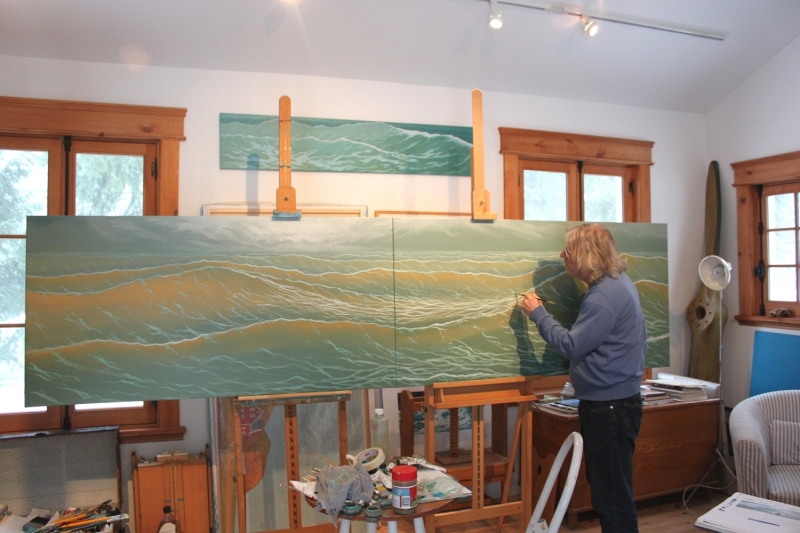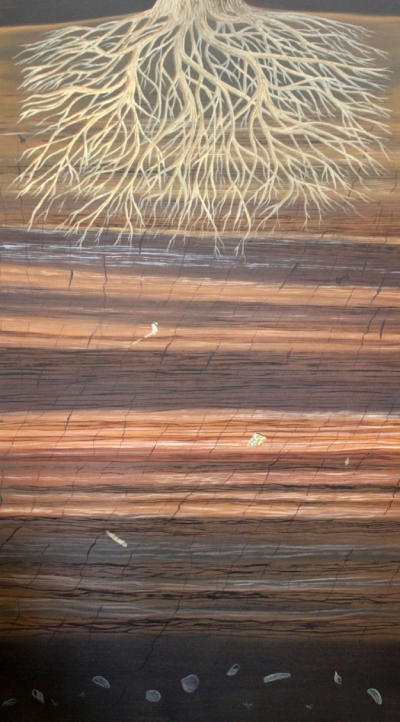Calendar of Events
July
August
September
Featured Artist:
Marcel Braitstein
Featured Organization:
Pure Art - The Maasai
Hudson Film Society:
How a Movie Is Chosen
Featured Event:
Mémoire de l'Eau
Featured Website:
Jen Baumeister's Pottery
Featured Event:
Art Along the Bike Path
Theatre:
Dance of the Spitfires
Mémoire de l’Eau
Daniel Gautier
au Musée de la Pointe-du-Buisson
Daniel Gautier is a Hudson-based artist who paints the ocean. He often focuses on scenes drawn from the Canadian Atlantic coast, but other canvases are more generic in showing waves, sea-scapes or iconic images. Born in Longueil, he was originally inspired by the Magdalen Islands. The internationally recognized artist now works out of his Hudson studio and exhibits this summer in Beauharnois.
At the end of the last ice age, about 12,000 years ago, Vaudreuil Soulanges was still covered with ice over one mile thick. The weight of the ice had depressed the land so that, when it melted, the low area formed a vast inland sea. This sea contained whales, dolphins and salt-water fish. As the land rose again when freed of the weight of the ice, the water drained into the Atlantic ocean and our area became a shallow lake. As more water drained, the present courses of the Ottawa and St. Lawrence rivers established themselves and early humans built canoes to travel along them. Today the Pointe du Buisson Archaeological Museum establishes the latest link in the chain of human occupancy along the river. It integrates what came before with what is happening today.

In his exhibition “La Mémoire de l’Eau”, Daniel Gautier tells this story with painted images, video and boards with French and English text. The exhibition at the Pointe du Buisson museum is unique in that it creates a synthesis of different media to produce an artistic narrative based on science.

Where the St. Lawrence River meets the branch of the Ottawa River flowing down the west side of Ile Perrot, the water flows across some shallow shelves of rock, forming short rapids. There are two dams here, but you can still see the rapids, about two miles downstream from the new bridge of the Autoroute 30. On the south shore of the St. Lawrence, across the river from Pointe de Cascades, there is a point of land with a large clearing that has been here for thousands of years. When the native people travelled up and down the St. Lawrence, they had to portage briefly around the rapids. The point with the clearing provided an ideal resting place. Shaded, exposed to the breezes of the river and consequently free of bugs, the site’s archaeological finds testify to the popularity of the location. When Europeans arrived, they too found the Pointe a pleasant place. Historical and archaeological records show that native people and Europeans shared the site until western civilization put a stop to the canoe travels up and down the river.

The exhibition starts with a large painting of a whale and continues with images of water, native legends, native fishermen as in the painting on the facing page and accompanying archaeological artifacts. There is a large painting of a native woman swimming in deep water alongside the turtle upon whose back, according to aboriginal legend, the world was created.
Below is a painting showing a different kind of memory - that of the soil. The museum carries out digs on the site and has found arrow heads and other old artifacts, just like in the painting, in different layers.

Below is a painting dealing with the most recent history - that of the lakers, the long, narrow freighters designed to fit the St, Lawrence Seaway locks, bringing wheat, coal and iron ore up and down the St. Lawrence and through the Great Lakes. The Assiniboine is operated by the Canada Steamship Lines. It never runs past the Pointe du Buisson - it has to take the S. Lawrence Seaway past the Beauharnois power station and through the Beauharnois canal.

You can drive slightly east over a bridge that crosses the sluice gates of the Beauharnois hydro-electric power station and see the water come out after powering the turbines and generators. That’s where most of the water passes now. It produces enough power to heat and light more than 100,000 museums like that at Pointe du Buisson. Although there is still a lot of water passing Pointe du Buisson, the cycle has shifted again.
Depuis la fin du dernier âge glaciaire et jusqu'à nos jours, l'eau a imprégné sa mémoire dans le paysage qui nous entoure ainsi que dans notre façon de voir le monde. C'est au travers de ce parcours chronologique, présenté par les œuvres, toiles et vidéos de l'artiste Daniel Gautier, que l'art et la science font équipe pour vous permettre une lecture de la grande épopée de l'eau et de l'humain dans la vallée du Saint-Laurent. Le cycle de l'eau est incessant et tous, nous en faisons partie.
Translation:
Since the end of the last ice age, and until today, water has impregnated the landscape that surrounds us and the way we view the world with its memory. Across this sequence of events, represented by the works and videos of the artist Daniel Gautier, art and science team up to let you read about the great saga of the water and humanity in the St. Lawrence Valley. The cycle of water is unceasing and we all are a part of it.
Below are links to Hudson-related websites:
